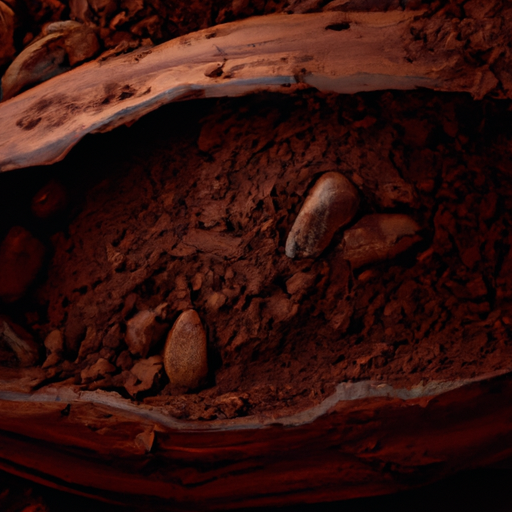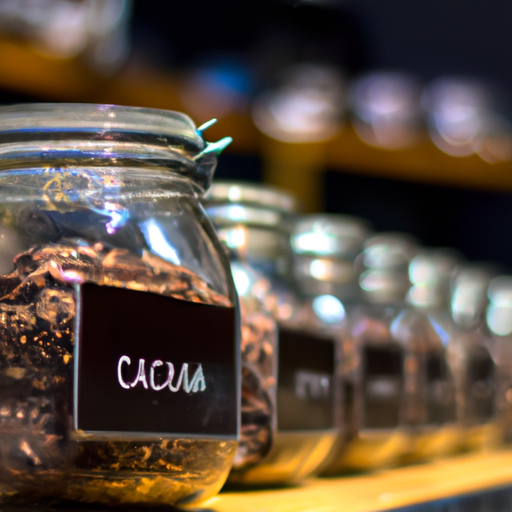Have you ever thought about how treating yourself to a luxurious dessert could actually have positive effects on your health? Allow me to introduce you to the world of raw cacao and its various benefits.
Picture yourself biting into a rich, velvety piece of chocolate that not only satisfies your cravings but also nourishes your body.
Raw cacao is a powerhouse of antioxidants, boasting a higher concentration than any other food on the planet. These antioxidants help to combat the damaging effects of free radicals and reduce inflammation in your body.
Not only that, but raw cacao is also packed with essential minerals like magnesium, iron, and zinc, which are vital for maintaining overall health.
But the benefits don’t stop there! Raw cacao has been shown to improve mood, support cardiovascular health, enhance cognitive function, and even boost athletic performance.
With so many incredible benefits, it’s time to start incorporating raw cacao into your daily routine and experience the chocolatey goodness that nourishes your body from the inside out.
Key Takeaways
- Raw cacao improves skin health and promotes a radiant complexion.
- It contains antioxidants that reduce signs of aging and protect the skin.
- Raw cacao has anti-inflammatory properties, reducing redness and inflammation.
- Incorporating raw cacao into the diet satisfies cravings, enhances overall well-being, and promotes overall skin health.
Introduction to Raw Cacao
Get ready to indulge in the rich and decadent world of raw cacao, because its benefits are about to blow your taste buds away!
Raw cacao has a fascinating history and origins that date back to the ancient Mayans and Aztecs, who revered it as a sacred food.
Today, raw cacao is available in various varieties and flavors, each with its own unique taste profile and nutritional benefits. From the smooth and creamy flavor of Criollo cacao to the bold and robust taste of Forastero cacao, there is something for every chocolate lover.
These different varieties also offer varying levels of antioxidants, which we will explore in the next section.
So, get ready to take a journey into the world of raw cacao and discover its rich source of antioxidants.
Rich Source of Antioxidants
Indulge in the rich flavor of raw cacao and discover how it provides your body with a whopping 40 times more antioxidants than blueberries. Raw cacao is a true powerhouse when it comes to health benefits. Here are five reasons why you should include raw cacao in your diet:
-
Boosts cardiovascular health: The antioxidants in raw cacao help protect against heart disease by reducing inflammation and improving blood flow.
-
Enhances mood and brain function: Raw cacao contains compounds that increase serotonin levels, promoting feelings of well-being and improving cognitive function.
-
Supports weight management: Raw cacao is low in calories and sugar, making it a guilt-free treat that can satisfy your sweet tooth without derailing your diet.
-
Natural remedy for stress: The flavonoids in raw cacao have been found to reduce stress hormones and promote relaxation.
-
Provides essential minerals: Raw cacao is a high source of magnesium, iron, and zinc, which are crucial for overall health and vitality.
Now, let’s delve into the next section about the high mineral content of raw cacao.
High Mineral Content
Discover the incredible mineral-rich profile of raw cacao and how it can give your body a natural boost of essential nutrients.
Raw cacao is not only a delicious treat, but it is also packed with minerals that are vital for our overall health. This superfood is a great source of magnesium, iron, zinc, and copper, which play important roles in supporting our body’s functions.
Magnesium, for example, helps promote relaxation and supports a healthy nervous system.
Incorporating raw cacao into your diet can be as simple as adding it to smoothies, oatmeal, or even baking it into healthy treats. Additionally, raw cacao supplements are available for those who want to enjoy its benefits in a convenient form.
Transitioning into the next section, raw cacao’s mood-boosting properties are another reason to incorporate this superfood into your routine.
Mood-Boosting Properties
Raw cacao’s mood-boosting properties are bound to captivate your attention. Studies show that incorporating this superfood into your diet can significantly improve overall happiness and reduce symptoms of stress and anxiety. But how does it do this? Here are three ways raw cacao enhances your mood and emotional well-being:
-
Boosts serotonin levels: Raw cacao contains tryptophan, an amino acid that helps increase serotonin production in the brain. Serotonin is a neurotransmitter that plays a crucial role in regulating mood, promoting feelings of happiness and well-being.
-
Enhances endorphin release: Raw cacao stimulates the release of endorphins, the body’s natural feel-good chemicals. These endorphins help elevate mood, reduce pain, and provide a sense of pleasure and relaxation.
-
Contains anandamide: Raw cacao is rich in anandamide, often referred to as the ‘bliss molecule.’ Anandamide binds to receptors in the brain, producing a blissful feeling and promoting a positive state of mind.
Incorporating raw cacao into your diet can have a profound impact on your emotional well-being. Transitioning to the subsequent section, let’s explore the cardiovascular health benefits of raw cacao.
Cardiovascular Health Benefits
One cannot underestimate the positive impact that incorporating raw cacao into your diet can have on your cardiovascular health. Numerous studies have shown that consuming raw cacao can improve heart health in several ways.
Firstly, it has been found to reduce inflammation and lower blood pressure, both of which are important factors in maintaining a healthy cardiovascular system. Additionally, raw cacao is rich in flavanols, which are antioxidants that promote blood vessel health and improve blood flow. This can lower the risk of developing heart disease and other cardiovascular conditions.
Furthermore, raw cacao has been shown to reduce LDL cholesterol levels, also known as the ‘bad’ cholesterol, while increasing HDL cholesterol levels, the ‘good’ cholesterol. These benefits make raw cacao a valuable addition to any heart-healthy diet.
Moving on to improved cognitive function, incorporating raw cacao into your daily routine can also have a positive impact on your brain health.
Improved Cognitive Function
Indulge in the rich, velvety goodness of raw cacao and watch as your mind becomes sharper and more focused. Raw cacao, with its high levels of flavonoids, has been shown to have significant benefits for cognitive function.
These flavonoids have been found to enhance focus and improve memory. Studies have shown that consuming raw cacao can increase blood flow to the brain, which in turn improves cognitive performance.
In addition, the antioxidants in raw cacao help protect brain cells from damage caused by oxidative stress. So, if you want to boost your brain power, incorporating raw cacao into your diet is a delicious and effective way to do so.
As we move on to the next section about enhanced athletic performance, it’s important to note that raw cacao can also have benefits in this area.
Enhanced Athletic Performance
Get ready to take your athletic performance to the next level by incorporating the rich and velvety goodness of raw cacao into your diet. Raw cacao is not only a delicious treat, but it also offers numerous benefits for athletes. Consuming raw cacao can lead to increased endurance and improved recovery, making it an ideal addition to your pre and post-workout routine.
To understand the benefits of raw cacao for athletic performance, take a look at the table below:
| Benefits of Raw Cacao for Athletes |
|---|
| Increased Endurance |
| Improved Recovery |
Raw cacao is packed with antioxidants and nutrients that help support muscle function, reduce inflammation, and enhance blood flow. These properties contribute to increased endurance during workouts and faster recovery after intense physical activity. By incorporating raw cacao into your diet, you can optimize your athletic performance and achieve your fitness goals.
With its ability to boost endurance and aid in recovery, raw cacao offers a natural and effective way to enhance your athletic performance. But the benefits don’t stop there. The next section will explore how raw cacao can improve your skin health.
Skin Health Benefits
Incorporating the velvety goodness of raw cacao into your diet can help transform your skin health. With its nourishing properties and ability to promote a radiant complexion, raw cacao offers several skin health benefits.
Raw cacao contains powerful antioxidants that protect the skin from free radicals, reducing signs of aging such as wrinkles and fine lines. These antioxidants also improve blood flow to the skin, giving it a healthy glow.
Additionally, raw cacao has anti-inflammatory properties that can help prevent acne breakouts by reducing redness and inflammation. It also contains minerals like magnesium and zinc, which promote collagen production and repair damaged skin.
To reap the skin benefits of raw cacao, try adding it to your smoothies, oatmeal, or even using it as a face mask.
Transitioning into the subsequent section, let’s explore some delicious ways to incorporate raw cacao into your daily diet.
Ways to Incorporate Raw Cacao into Your Diet
One easy way to start enjoying the rich flavor and health benefits of raw cacao is by adding it to your morning smoothie or oatmeal. Here are a couple of ideas to help you incorporate raw cacao into your diet:
-
For a delicious and healthy dessert, try making a raw cacao smoothie. Simply blend together a frozen banana, almond milk, a tablespoon of raw cacao powder, and a drizzle of honey or maple syrup. This smoothie is not only a satisfying treat but also packed with antioxidants and minerals.
-
Another option is to sprinkle raw cacao nibs on top of your oatmeal. This adds a crunchy texture and a rich chocolate flavor that will make your breakfast feel like a decadent treat. Plus, the antioxidants in raw cacao can help protect your skin and promote overall skin health.
By incorporating raw cacao into your diet, you can enjoy its numerous health benefits while satisfying your sweet tooth.
Frequently Asked Questions
Can raw cacao help with weight loss?
Raw cacao can aid weight loss by boosting metabolism and suppressing appetite. Research indicates that consuming raw cacao can increase calorie burn by up to 20% and reduce cravings, making it a helpful tool for those looking to shed pounds.
Is raw cacao safe for children to consume?
Raw cacao is generally safe for children to consume in moderation. Safety concerns may include potential allergenicity and caffeine content. The recommended serving size for children is 1-2 teaspoons per day.
Does raw cacao have any potential negative side effects?
Raw cacao can have potential risks, such as allergic reactions. It’s important to be aware of any allergies and consult with a healthcare professional before consuming.
Can raw cacao be beneficial for people with diabetes?
Raw cacao can be beneficial for people with diabetes. It has been shown to have a positive impact on blood sugar levels, which can help regulate glucose levels and improve insulin sensitivity.
What are the differences between raw cacao and regular chocolate?
Raw cacao is the unprocessed form of chocolate and has more health benefits than regular chocolate. It contains higher levels of antioxidants, minerals, and flavonoids which can support heart health, improve mood, and boost brain function.
Are the Benefits of Raw Cacao Powder the Same as Raw Cacao?
Yes, the health benefits of cacao powder are the same as raw cacao. Both contain powerful antioxidants, magnesium, and iron, which can improve heart health, reduce inflammation, and boost mood. Additionally, cacao powder retains its nutrients since it is not heated or processed like cocoa.
Conclusion
In conclusion, incorporating raw cacao into your diet can offer numerous benefits for your overall health and well-being.
The high antioxidant content helps combat oxidative stress and promotes a healthy immune system.
Raw cacao is also packed with essential minerals that support various bodily functions.
Its mood-boosting properties can improve mental well-being, and its cardiovascular benefits contribute to a healthy heart.
Additionally, raw cacao can enhance cognitive function, athletic performance, and even promote healthy skin.
With so many advantages, it’s worth considering adding raw cacao to your daily routine.









